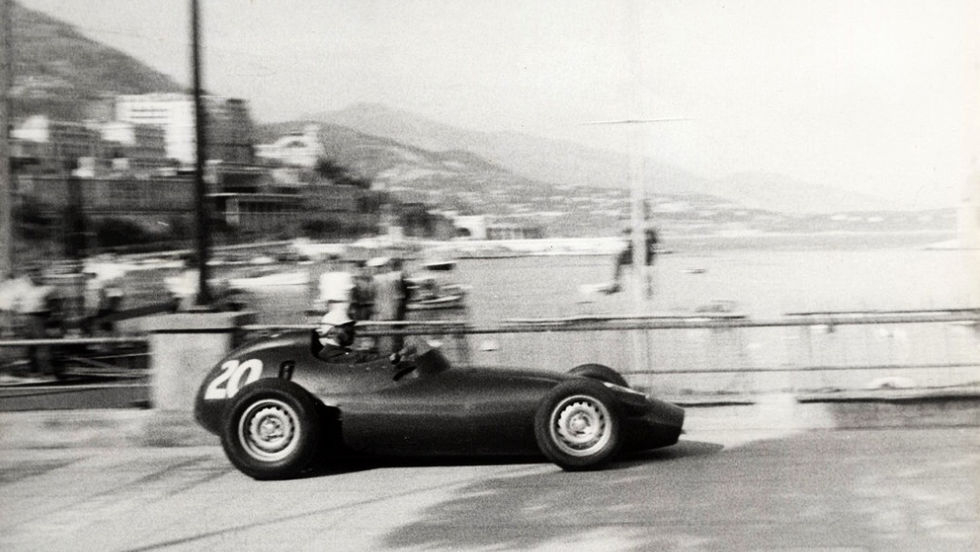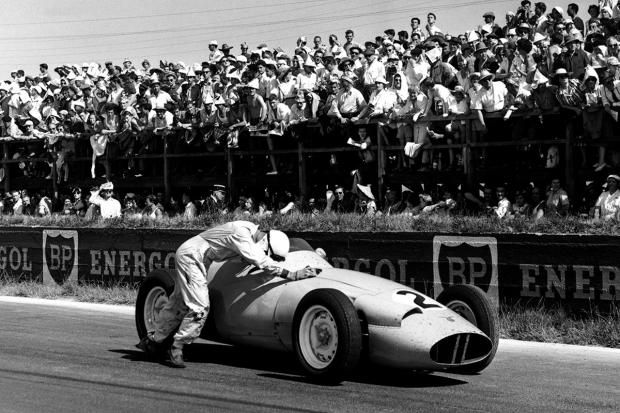
1959 BRM P25
2510
ARGUABLY THE MOST COMPETITIVE & FINEST HANDLING FRONT-ENGINED GP CAR
ELIGIBLE FOR GOODWOOD'S REVIVAL & MEMBERS' MEETING, MONACO'S GP HISTORIQUE & HGPCA
RECONSTRUCTION COMMISSIONED DURING THE 1960S BY WHEATCROFT FOR THE DONINGTON COLLECTION
THE IDENTITY OF 2510 WAS WAS GIVEN TO THE CAR DURING ITS RECONSTRUCTION. CHASSIS 2510 WAS RACED BY STIRLING MOSS, RON FLOCKHART & HANS HERMANN BOTH AS A WORKS CAR & AS A BRITISH RACING PARTNERSHIP (BRP) ENTRY.
BASED ON MANY GENUINE PARTS PURCHASED DIRECTLY FROM BRM BY FAMED COLLECTOR TOM WHEATCROFT
MAINTAINED EVER SINCE BY BRM SPECIALISTS HALL & HALL. INCLUDES THE ORIGINAL P25 ENGINE NUMBER 2592

The British Racing Motors, or BRM as it affectionately became known, was more than a Formula One racing team, it was a national effort to perform at the top level of motorsport and bring sporting glory to Great Britain. Founded after WW2 by ex-racing driver Raymond Mays (also the man behind the ERA Grand Prix car company) and engineer Peter Berthon. Formed in the aftermath of WW2, as motor racing was just beginning once again, the BRM project was very much billed as the national Grand Prix team. This was significant because at the time, national pride was still very much a core element of Grand Prix teams’ identities.
BRM succeeded in capturing the nation’s hearts, and indeed much of this was fuelled by the press, with it dubbed ‘Britain’s Greatest Racing Car’. The P15 car was a hugely ambitious and tremendously complicated design featuring a 1.5-litre supercharged V16 engine capable of 400+bhp at a staggering 12,000 rpm. Developing and racing such a car required huge amounts of funding and many engineering collaborations, so in order to achieve this, Mays and Berthon created the British Motor Racing Research Trust. Ultimately they persuaded twenty two of Britain’s leading automotive and engineering companies to support their endeavour.

Despite its staggering performance the P15 ultimately proved frustrating for BRM across several seasons and iterations, with the company eventually being wound up in 1953. BRM was ultimately saved by the Owen Organisation who kept the endeavour as a whole and Berthon was tasked with creating a simpler, more reliable machine for the new forthcoming 2.5-litre F1 regulations. Berthon opted for the simplicity of a 4-cylinder all-aluminium twin-cam engine that would sit in a lightweight space-frame chassis. The engine breathed through a pair of huge twin-choke Weber carburetors (the only step away from BRM’s all-British supply policy), and produced over 250 bhp. The P25’s space-frame chassis featured double wishbone and coil spring suspension at the front, and coil springs with a DeDion rear axle. The use of brake discs at the front was completed by a unique, inboard rear disc mounted on the back of the transaxle gearbox. From 1955, the Type 25 (or P25 as it widely became known) development would spread over several years as the car initially proved unreliable and tricky to drive.
Although the design was simpler, reliability was again a constant issue and it wasn’t until midway through 1958 that the P25s finished a race. It is said that the signing of Jean Behra for the ‘58 season was pivotal in ironing our the P25’s handling issues, and indeed the results began to improve. A fifth place at Monaco in 1958 was the best result yet, followed by second and third place at Zandvoort. Ultimately the P25 proved popular with its drivers and was a much more competitive machine in its la58/59 guise. 1959 would see the P25’s best results with Jo Bonnier winning the Dutch GP at Zandvoort, which was indeed BRM’s first F1 victory, followed by Stirling Moss’ second place taking 2nd in the British GP at Aintree (in chassis 2510). By that time however, the mid-engined Cooper revolution had begun, and BRM hurredly began designing the new P48. Albeit being mid-engined, the P48 had a somewhat similar chassis and suspension design, and used the same engine and gearbox. As a result, most of the P25 cars were used as donor cars, and so today only one totally original example exists.



2510
Chassis 2510 was originally one of two new cars built for the 1959 season. It was raced once as a works entry when driven by Ron Flockhart in the Monaco Grand Prix. Flockhart qualified 10th but the race proved one to forget with him spinning into retirement after 64 laps. Soon after it was sold to the new team, British Racing Partnership or BRP as it became known. BRP was very well funded, enjoying sponsorship from Yeoman Credit, a British hire-purchase company. BRP brought in arguably Britain’s star of the time, Sir Stirling Moss to drive the P25 in both the French and British Grands Prix. Moss immediately proved his worth by qualifying 4th and fastest of all four BRM entries. However in the race with Moss pushing hard in very hot conditions, he spun and stalled. He tried in vain to push start the car himself, he collapse from exhaustion and was later disqualified for receiving outside assistance. However he did earn fastest lap of the race and a new lap record in the process.
Two weeks later Moss was back in 2510 for the British Grand Prix at Aintree. Qualifying 7th, Moss drove brilliantly and worked his way up to 2nd place after 75 laps and shared fastest lap with Bruce McLaren. For the final race of 2510’s short career, German driver Hans Herrman was chosen. Qualifying 11th Herrmann was pushing the P25 hard in the race, only to suffer brake failure as he arrived into the Sudschleife (South Loop) corner. 2510 barrel-rolled down the escape road in a spectacular fashion, throwing Herrmann clear underneath as the car rolled overhead. Rather miraculously he escaped with very minor injuries, but the crash was the end of 2510’s active career. The whole incident was captured in what became a rather famous series of photos.
Fast forward to the late 1960s and budding collector Tom Wheatcroft negotiated to purchase a huge amount of BRM’s spare parts from the 1950s and 1960s. Wanting a P25 for his new Donington Museum, Wheatcroft commissioned the reconstruction of a P25 making perfect use of his extensive newly acquired spares inventory. Wheatcroft elected to call the car 2510, since the original had been crashed in spectacular fashion by Hans Hermann at Avus in 1959, and so the car was painted BRP’s iconic shade of pale green. It isn’t recorded if the original crash-damaged chassis of 2510 was amongst the spares Wheatcroft bought from BRM.
Original blueprints were used to construct the chassis and original bucks for the body. Wheatcroft then incorporated a large number of the original components he had from his huge spares inventory, including the engine numbered 2592. Original BRM records show that engine 2592 was used by the works team during 1959 powering Jo Bonnier in the International 100 at Goodwood, the Aintree 200 and then Ron Flockhart in the Monaco GP. Once run in around Donington, the reborn 2510 was put on display in the Donington Museum, where it remained (aside from occasional demonstration outings) until acquired by the current owner in 2012.
Immediately after acquiring 2510, the owner sent it to the world’s leading BRM specialists, Hall & Hall, for race preparation. 2510 then went on the win the Hawthorn Trophy at the 73rd Goodwood Members Meeting, and finished 6th in the Brooks Trophy (which by that time was a mix of front and mid-engined cars) the following year. With less than ten examples in existence today (all except one being reconstructions using original parts), these are very rare cars. 2510 presents an ideal opportunity for a discerning F1 collector looking to acquire one of the prettiest and most competitive front-engined F1 cars of all time. The P25 is a widely eligible and very competitive option for many of the world’s finest events such as the Goodwood Revival, Monaco Historic GP, plus the Historic Grand Prix Cars Association in Europe and HSR in the USA.



























